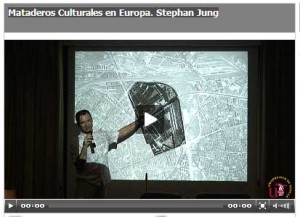- CONFERENCIA. Mataderos Culturales en Europa
- ARQUITECTO. Stephan Jung
- Arquitecto por la Bauhaus Universität Weimar, Alemania. Doctor Universidad de Milán, Italia.
- ALAD (Architecture Land Ambient Design) web: www.aladlabs.net /blog /twitter: @ALADlabs
- ENLACE AL VIDEO DE LA CONFERENCIA
RESUMEN___Cities in cities. One of the more significant opportunities for the sustainable development of our cities is the redevelopment of abandoned urban areas. There are a number of urban spaces that have lost their so-called intended use. Factories have been moved to more remote areas or even abroad, transport infrastructure is subject to a progressive mutation, even in their physical constitution, public services or ex-military areas have been moved or abandoned. Each of these cases has its very own physicality and, therefore, its own peculiar potential.One of the most interesting categories of cases of urban regeneration is the re-use of urban areas formerly dedicated to the function of urban food supply and more specifically the reuse of urban slaughterhouses. Municipal slaughterhouses in Europe are characterized by a series of very specific conditions, conditions that turn them into suitable objects for a public intervention and of urban transformation, interventions which can very often reactivate entire urban neighborhoods.As large public properties they are subject to urban planning and an at least partial public use is the most appropriate in terms of civic responsibility. In addition, municipal slaughterhouses of second and third generation, once on the edge of the city, are now often located in central areas.Research investigates the whole scenario produced by redevelopment projects covering a time span ranging from the 70s to present day and brings together design experiences of various scales and sizes. In particular, it explores the intersection between architecture and other disciplines which belong necessarily to this issue. When redevelopment becomes a process architecture stops to deal primarily with the production of new architectural objects, and a change occurs to the operational strategies, processes and tools put in place by architects.
*Actividad asociada al I Seminario Internacional Rehabilitación y Mejoramiento de Barrios: Investigación, Gestión y Acción, desarrollado por el grupo de cooperación internacional Arquitectura, Territorio y Salud (ArTeS) en la Escuela Técnica Superior de Arquitectura de Sevilla los días 20 y 21 de septiembre de 2012 con motivo del convenio de Cooperación Internacional firmado entre las Universidades UMSS de Cochabamba, UV de Valparaiso, Universidad de Sevilla, Universidad de Málaga y Universidad de Granada.
